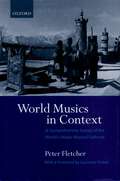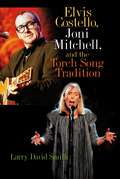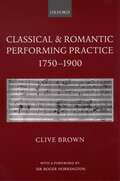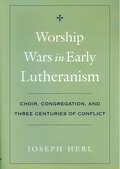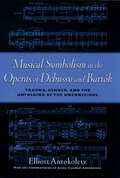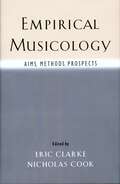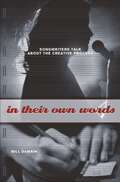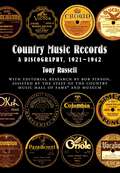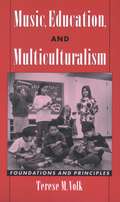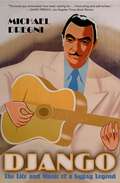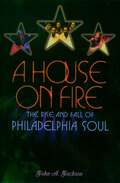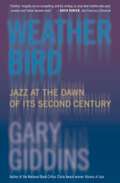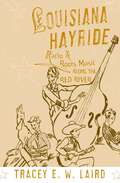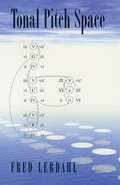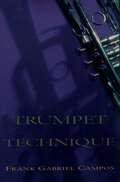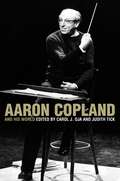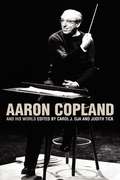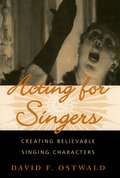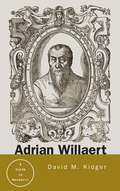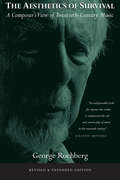- Table View
- List View
World Musics in Context: A Comprehensive Survey of the World's Major Musical Cultures
by Peter FletcherWorld Musics in Context is a wide-ranging survey of musics of the world, in their historical and social contexts, from ancient times to the present day. Ethnomusicologist Peter Fletcher begins by describing aspects of musical style and function in relation to the early developments of civilizations. He then goes on to explore, in five parts, music of the ancient world, music of Africa and Asia, European music, North and South American traditions, and music of the modern world. A compendium of information as well as an examination of musical causation and function, this book gives a deeper understanding of the various musical traditions that contribute to the modern, multicultural environment.
Elvis Costello, Joni Mitchell, and the Torch Song Tradition
by Larry David SmithThe torch song has long been a vehicle for expression—perhaps American song's most sheerly visceral one. Two artists in particular have built upon this tradition to express their own unique outlooks on their lives and the world around them. Joni Mitchell, Elvis Costello, and the Torch Song Tradition combines biographical material, artist commentary, critical interpretation, and selected exemplars of the writers' work to reveal the power of authorship and the creative drive necessary to negotiate an artistic vision in the complicated mechanisms of the commercial music industry. Author Larry David Smith, as in his Bob Dylan, Bruce Springsteen, and American Song, considers the complicated intersection of biography, creative philosophy, artistic imperative, and stylistic tendencies in the work of both Joni Mitchell and Elvis Costello—two songwriters with seemingly nothing in common, one famously confessional and one famously confrontational. Yet, as Smith shows so incisively, they are two personalities that prove fascinatingly complementary.Mitchell and Costello both yielded bodies of work that are cohesive, coherent, and rich in meaning. Both have made historic contributions to the singer-songwriter model, two rebellious respones to the creative and commercial compromises associated with their chosen field, and two distinct thematic responses to the torch song tradition. Smith examines these responses, offering a unique and invaluable exploration of the craft of two of the last century's most towering musical figures.
Classical and Romantic Performing Practice 1750-1900
by Clive BrownThe past ten years have seen a rapidly growing interest in performing and recording Classical and Romantic music with period instruments; yet the relationship of composers' notation to performing practices during that period has received only sporadic attention from scholars, and many aspects of composers' intentions have remained uncertain. Brown here identifies areas in which musical notation conveyed rather different messages to the musicians for whom it was written than it does to modern performers, and seeks to look beyond the notation to understand how composers might have expected to hear their music realized in performance. There is ample evidence to demonstrate that, in many respects, the sound worlds in which Mozart, Beethoven, Wagner, and Brahms created their music were more radically different from ours than is generally assumed.
Highway 61 Revisited: The Tangled Roots of American Jazz, Blues, Rock, & Country Music
by Gene SantoroWhat do Louis Armstrong, Ray Charles, Bob Dylan, Willie Nelson, Tom Waits, Cassandra Wilson, and Ani DiFranco have in common? In Highway 61 Revisited, acclaimed music critic Gene Santoro says the answer is jazz--not just the musical style, but jazz's distinctive ambiance and attitudes. As legendary bebop rebel Charlie Parker once put it, "If you don't live it, it won't come out of your horn." Unwinding that Zen-like statement, Santoro traces how jazz's existential art has infused outstanding musicians in nearly every wing of American popular music--blues, folk, gospel, psychedelic rock, country, bluegrass, soul, funk, hiphop--with its parallel process of self-discovery and artistic creation through musical improvisation. Taking less-traveled paths through the last century of American pop, Highway 61 Revisited maps unexpected musical and cultural links between such apparently disparate figures as Louis Armstrong, Willie Nelson, Bob Dylan and Herbie Hancock; Miles Davis, Lenny Bruce, The Grateful Dead, Bruce Springsteen, and many others. Focusing on jazz's power to connect, Santoro shows how the jazz milieu created a fertile space "where whites and blacks could meet in America on something like equal grounds," and indeed where art and entertainment, politics and poetry, mainstream culture and its subversive offshoots were drawn together in a heady mix whose influence has proved both far-reaching and seemingly inexhaustible. Combining interviews and original research, and marked throughout by Santoro's wide ranging grasp of cultural history, Highway 61 Revisited offers readers a new look at--and a new way of listening to--the many ways jazz has colored the entire range of American popular music in all its dazzling profusion.
Worship Wars in Early Lutheranism: Choir, Congregation, and Three Centuries of Conflict
by Joseph HerlHow important was music to Martin Luther? Drawing on hundreds of liturgical documents, contemporary accounts of services, books on church music, and other sources, Joseph Herl rewrites the history of music and congregational song in German Lutheran churches. Herl traces the path of music and congregational song in the Lutheran church from the Reformation to 1800, to show how it acquired its reputation as the "singing church." In the centuries after its founding, in a debate that was to have a strong impact on Johann Sebastian Bach and his contemporaries, the Lutheran church was torn over a new style of church music that many found more entertaining than devotional. By the end of the eighteenth century, Lutherans were trying to hold their own against a new secularism, and many members of the clergy favored wholesale revision or even abandonment of the historic liturgy in order to make worship more relevant in contemporary society. Herl paints a vivid picture of these developments, using as a backdrop the gradual transition from a choral to a congregational liturgy. The author eschews the usual analyses of musical repertoire and deals instead with events, people and ideas, drawing readers inside the story and helping them sense what it must have been like to attend a Lutheran church in the sixteenth through eighteenth centuries. Parallel developments in Catholic churches are discussed, as are the rise of organ accompaniment of hymns and questions of musical performance practice. Although written with academic precision, the writing is clear and comprehensible to the nonspecialist, and entertaining anecdotes abound. Appendixes include translations of several important historical documents and a set of tables outlining the Lutheran mass as presented in 172 different liturgical orders. The bibliography includes 400 Lutheran church orders and reports of ecclesiastical visitations read by the author.
Musical Symbolism in the Operas of Debussy and Bartok
by Elliot AntokoletzMusical Symbolism in the Operas of Debussy and Bartók explores the means by which two early 20th century operas - Debussy's Pelléas et Mélisande (1902) and Bartók's Duke Bluebeard's Castle (1911) - transformed the harmonic structures of the traditional major/minor scale system into a new musical language. It also looks at how this language reflects the psychodramatic symbolism of the Franco-Belgian poet, Maurice Maeterlinck, and his Hungarian disciple, Béla Balázs. These two operas represent the first significant attempts to establish more profound correspondences between the symbolist dramatic conception and the new musical language. Duke Bluebeard's Castle is based almost exclusively on interactions between pentatonic/diatonic folk modalities and their more abstract symmetrical transformations (including whole-tone, octatonic, and other pitch constructions derived from the system of the interval cycles). The opposition of these two harmonic extremes serve as the basis for dramatic polarity between the characters as real-life beings and as instruments of fate. The book also explores the new musico-dramatic relations within their larger historical, social psychological, philosophical, and aesthetic contexts.
Drummin' Men: The Heartbeat of Jazz: The Bebop Years
by Burt KorallBurt Korall is widely recognized as the most authoritative writer on jazz drumming. His first book Drummin' Men--The Heartbeat of Jazz: The Swing Era is considered a classic. Now, in this exciting sequel, Korall offers a richly informative history of drumming in the Bebop era. Korall looks at this music through the eyes of the musicians themselves, covering a whole range of important jazz drummers, but focusing upon the most original and significant--principally Kenny Clarke, Max Roach, and Art Blakey. Korall provides a knowledgeable background about the history of bebop--and the unfortunate and almost universal heroin addiction that swept through the jazz world in the wake of Charlie Parker's habit. The book contains Korall's own memoir of nearly 50 years in the jazz world, linked by his narrative of the careers of these drummers and their place in the bebop jazz scene.
Empirical Musicology: Aims, Methods, Prospects
by Nicholas Cook Eric ClarkeThe study of music is always, to some extent, "empirical," in that it involves testing ideas and interpretations against some kind of external reality. But in musicology, the kinds of empirical approaches familiar in the social sciences have played a relatively marginal role, being generally restricted to inter-disciplinary areas such as psychology and sociology of music. Rather than advocating a new kind of musicology, Empirical Musicology provides a guide to empirical approaches that are ready for incorporation into the contemporary musicologist's toolkit. Its nine chapters cover perspectives from music theory, computational musicology, ethnomusicology, and the psychology and sociology of music, as well as an introduction to musical data analysis and statistics. This book shows that such approaches could play an important role in the further development of the discipline as a whole, not only through the application of statistical and modeling methods to musical scores but also--and perhaps more importantly--in terms of understanding music as a complex social practice.
In Their Own Words: Songwriters Talk About the Creative Process
by Bill DeMainThe interviews included in this fascinating collection of discussions with popular songwriters focus on the craft itself—and as such, they are of interest to both music fans and to budding songwriters. What inspires songwriters? Where do their songs come from? What is their process? What do they do when they get stuck? In this book, readers will hear from a vast range of well-known, successful songwriters, many of them performers as well, revealing the nuances of their skill: how they write their songs, from conception to finished work. The book discusses both song history and style. The songs discussed have defined eras and culture.Full of trivia, wisdom, and fascinating revelations from such figures as Tori Amos, Burt Bacharach, David Bowie, Sarah McLachlan, Billy Joel, and John Mayer, In Their Own Words shines a light on what is often and inherently lonely craft. It gives readers a glimpse into a mysterious process and offes rising songwriters a wealth of advice from those who have spent decades successfully sharing their work with the public.
Country Music Records: A Discography, 1921-1942
by Tony Russell Bob PinsonMore than twenty years in the making, Country Music Records documents all country music recording sessions from 1921 through 1942. With primary research based on files and session logs from record companies, interviews with surviving musicians, as well as the 200,000 recordings archived at the Country Music Hall of Fame and Museum's Frist Library and Archives, this notable work is the first compendium to accurately report the key details behind all the recording sessions of country music during the pre-World War II era. This discography documents--in alphabetical order by artist--every commercial country music recording, including unreleased sides, and indicates, as completely as possible, the musicians playing at every session, as well as instrumentation. This massive undertaking encompasses 2,500 artists, 5,000 session musicians, and 10,000 songs. Summary histories of each key record company are also provided, along with a bibliography. The discography includes indexes to all song titles and musicians listed.
Music, Education, and Multiculturalism: Foundations and Principles
by Terese M. VolkIn today's multi-ethnic classroom, multiculturalism plays an increasingly vital role. What it is, how it developed, and what it means for education, especially music education, are the questions that form the essence of this book. Music, Education, and Multiculturalism traces the growth and development of multicultural music education in the United States from its start in the early 1900s to the present, and describes the state of multicultural music education internationally. Beginning with a discussion of the philosophical foundations surrounding multiculturalism, Part I addresses the various definitions of multiculturalism and its associated problems and possibilities in both education at large and music education in particular. It offers a succinct discussion of the various philosophical concepts and rationales for a multicultural approach, and concludes with current thoughts and applications in music education. Part II follows multicultural music education in the U.S. as it paralleled changes in general education brought about by social and historical events. The last chapter in this section outlines multiculturalism in music education around the world. Part III focuses on the implications of multiculturalism for music education, both in teacher training and in classroom instruction. Designed to assist music educators at all levels in understanding and implementing multicultural education, Music, Education, and Multiculturalism provides suggestions for curricular development, offers teaching strategies, and provides practical applications including materials and methodologies. Combining personal narrative and oral history with the support of primary and archival documents, this text is essential reading for all students and teachers of the history and foundations of music education and of multiculturalism in general education.
Django: The Life and Music of a Gypsy Legend
by Michael DregniDjango Reinhardt was arguably the greatest guitarist who ever lived, an important influence on Les Paul, Charlie Christian, B.B. King, Jerry Garcia, Chet Atkins, and many others. Yet there is no major biography of Reinhardt. Now, in Django, Michael Dregni offers a definitive portrait of this great guitarist. Handsome, charismatic, childlike, and unpredictable, Reinhardt was a character out of a picaresque novel. Born in a gypsy caravan at a crossroads in Belgium, he was almost killed in a freak fire that burned half of his body and left his left hand twisted into a claw. But with this maimed left hand flying over the frets and his right hand plucking at dizzying speed, Django became Europe's most famous jazz musician, commanding exorbitant fees--and spending the money as fast as he made it. Dregni not only chronicles this remarkably colorful life--including a fascinating account of gypsy culture--but he also sheds much light on Django's musicianship. He examines his long musical partnership with violinist Stéphane Grappelli--the one suave and smooth, the other sharper and more dissonant--and he traces the evolution of their novel string jazz ensemble, Quintette du Hot Club de France. Indeed, the author spotlights Django's amazing musical diversity, describing his swing-styled Nouveau Quintette, his big band Django's Music, and his later bebop ensemble, as well as his many compositions, including symphonic pieces influenced by Ravel and Debussy and his unfinished organ mass inspired by Bach. And along the way, the author offers vivid snapshots of the jazz scene in Paris--colorful portraits of Josephine Baker, Bricktop, Louis Armstrong, Coleman Hawkins, and countless others--and of Django's vagabond wanderings around France, Europe, and the United States, where he toured with Duke Ellington. Capturing the extraordinary life and times of one of the great musicians of the twentieth century, Django is a must-read portrait of a true original.
A House on Fire: The Rise and Fall of Philadelphia Soul
by John A. Jackson"If You Don't Know Me By Now," "The Love I Lost," "The Soul Train Theme," "Then Came You," "Ain't No Stoppin' Us Now"--the distinctive music that became known as Philly Soul dominated the pop music charts in the 1970s. In A House on Fire, John A. Jackson takes us inside the musical empire created by Kenny Gamble, Leon Huff, and Thom Bell, the three men who put Philadelphia Soul on the map. Here is the eye-opening story of three of the most influential and successful music producers of the seventies. Jackson shows how Gamble, Huff, and Bell developed a black recording empire second only to Berry Gordy's Motown, pumping out a string of chart-toppers from Harold Melvin & the Blue Notes, the Spinners, the O'Jays, the Stylistics, and many others. The author underscores the endemic racism of the music business at that time, revealing how the three men were blocked from the major record companies and outlets in Philadelphia because they were black, forcing them to create their own label, sign their own artists, and create their own sound. The sound they created--a sophisticated and glossy form of rhythm and blues, characterized by crisp, melodious harmonies backed by lush, string-laden orchestration and a hard-driving rhythm section--was a glorious success, producing at least twenty-eight gold or platinum albums and thirty-one gold or platinum singles. But after their meteoric rise and years of unstoppable success, their production company finally failed, brought down by payola, competition, a tough economy, and changing popular tastes. Funky, groovy, soulful--Philly Soul was the classic seventies sound. A House on Fire tells the inside story of this remarkable musical phenomenon.
Weather Bird: Jazz at the Dawn of Its Second Century
by Gary GiddinsGary Giddins's Weather Bird is a brilliant companion volume to his landmark in music criticism, Visions of Jazz, winner of the National Book Critics Circle Award in Criticism. More then 140 pieces, written over a 14-year period, are brought together for the first time in this superb collection of essays, reviews, and articles. Weather Bird is a celebration of jazz, with illuminating commentaryon contemporary jazz events, today's top muscicians, the best records of the year, and on leading figures from jazz's past. Readers will find extended pieces on Louis Armstrong, Erroll Garner, Benny Carter, Sonny Rollins, Dave Brubeck, Ornette Coleman, Billie Holiday, Cassandra Wilson, Tony Bennett, and many others. Giddins includes a series of articles on the annual JVC Jazz Festival, which offers a splendid overview of jazz in the 1990s. Other highlights include an astute look at avant-garde music ("Parajazz") and his challenging essay, "How Come Jazz Isn't Dead?" which advances a theory about the way art is born, exploited, celebrated, and sidelined to the museum. A radiant compendium by America's leading music critic, Weather Bird offers an unforgettable look at the modern jazz scene.
Louisiana Hayride: Radio and Roots Music along the Red River (American Musicspheres)
by Tracey E. LairdOn a Saturday night in 1948, Hank Williams stepped onto the stage of the Louisiana Hayride and sang "Lovesick Blues." Up to that point, Williams's yodeling style had been pigeon-holed as hillbilly music, cutting him off from the mainstream of popular music. Taking a chance on this untried artist, the Hayride--a radio "barn dance" or country music variety show like the Grand Ole Opry--not only launched Williams's career, but went on to launch the careers of well-known performers such as Jim Reeves, Webb Pierce, Kitty Wells, Johnny Cash, and Slim Whitman. Broadcast from Shreveport, Louisiana, the local station KWKH's 50,000-watt signal reached listeners in over 28 states and lured them to packed performances of the Hayride's road show. By tracing the dynamic history of the Hayride and its sponsoring station, ethnomusicologist Tracey Laird reveals the critical role that this part of northwestern Louisiana played in the development of both country music and rock and roll. Delving into the past of this Red River city, she probes the vibrant historical, cultural, and social backdrop for its dynamic musical scene. Sitting between the Old South and the West, this one-time frontier town provided an ideal setting for the cross-fertilization of musical styles. The scene was shaped by the region's easy mobility, the presence of a legal "red-light" district from 1903-17, and musical interchanges between blacks and whites, who lived in close proximity and in nearly equal numbers. The region nurtured such varied talents as Huddie Ledbetter, the "king of the twelve-string guitar," and Jimmie Davis, the two term "singing governor" of Louisiana who penned "You Are My Sunshine." Against the backdrop of the colorful history of Shreveport, the unique contribution of this radio barn dance is revealed. Radio shaped musical tastes, and the Hayride's frontier-spirit producers took risks with artists whose reputations may have been shaky or whose styles did not neatly fit musical categories (both Hank Williams and Elvis Presley were rejected by the Opry before they came to Shreveport). The Hayride also served as a training ground for a generation of studio sidemen and producers who steered popular music for decades after the Hayride's final broadcast. While only a few years separated the Hayride appearances of Hank Williams and Elvis Presley--who made his national radio debut on the show in 1954--those years encompassed seismic shifts in the tastes, perceptions, and self-consciousness of American youth. Though the Hayride is often overshadowed by the Grand Ole Opry in country music scholarship, Laird balances the record and reveals how this remarkable show both documented and contributed to a powerful transformation in American popular music.
Sacred Passions: The Life and Music of Manuel de Falla
by Carol A. HessThe work of composer Manuel de Falla (1876-1946) ranges from late-romantic salon pieces to evocations of flamenco to stark neoclassicism. Yet his music has met with conflicting reactions, depending on the audience. In his native Spain, Falla is considered the most innovative composer of the first half of the twentieth century. Likewise, in the United States, Falla enjoyed a strong following in the concert hall. But many of his works, especially some of the "colorful" or "exotic" dances from The Three-Cornered Hat and El Amor Brujo, were taken up during the Latin music craze of the 1930s and 40s and appeared in everything from jazz and pop arrangements to MGM musicals. Similarly enigmatic are the details of Falla's life. He never sustained a lasting, intimate relationship with a woman, yet he created compelling female roles for the lyric stage. Although he became incensed when publishers altered his music, he more than once tinkered with Chopin and Debussy. Despite insisting that he was apolitical, Falla ultimately took sides in the Spanish Civil War, initially allying himself rather half-heartedly with Franco's Nationalists but later rejecting the honors they proffered. All his life, his rigorous brand of Roman Catholicism brought him both solace and agony in his quest for spiritual and artistic perfection. In Sacred Passions: The Life and Music of Manuel de Falla, Carol A. Hess explores these contradictions and offers a fresh understanding of this fascinating composer. Building on over a decade of research, Hess examines Falla's work in terms of musical style and explores the cultural milieus in which he worked. During a seven-year sojourn to Paris just pior to World War I, Falla associated with composers Dukas, Stravinsky, Ravel, and the rest of the group known as les Apaches. Later, back in Spain, he played a pivotal role in the remarkable cultural renaissance known as the "Silver Age," during which Lorca, Buñuel, Dalí, Unamuno-and of course Falla himself-made some of their boldest artistic statements. Hess also explores a number of myths cultivated in earlier biographies, including Falla's supposed misogynistic tendencies and accusations of homosexuality, which have led some biographers to consider him a saint-like ascetic. She offers a balanced view of his behavior during the Spanish Civil War, a wrenching event for a Spaniard of his generation, and one that Falla biographers have left largely untouched. With superb analysis of his music and enlightening detail about its critical reception, Hess also examines Falla's status in some circles as little more than a high-class pop composer, given the mass appeal of much of his music. She incorporates recent research on Falla, draws upon untapped sources in the Falla archives, and reevaluates his work in terms of current issues in musicology. Ultimately, Hess places Falla's variegated ouevre, which straddles popular and serious idioms, securely among the best of his better-known European contemporaries. What emerges is a gracefully written, balanced portrait of a man whose lofty spiritual values inspired singular musical utterances but were often at odds with the decidedly imperfect world he inhabited.
Tonal Pitch Space
by Fred LerdahlBuilding on the foundation of Lerdahl and Jackendoff's influential A Generative Theory of Tonal Music, this volume presents a multidimensional model of diatonic and chromatic spaces that quantifies listeners' intuitions of the relative distances of pitches, chords, and keys from a given tonic. The model is employed to assign prolongational structure, represent paths through the space, and compute patterns of tension and attraction as musical events unfold, thereby providing a partial basis for understanding musical narration, expectation, and expression. Conceived as both a music-theoretic treatise and a contribution to the cognitive science of music, this book will be of interest to music theorists, musicologists, composers, computer musicians, and cognitive psychologists.
The Encyclopedia of Country Music
by The Country Music Hall of Fame and Museum Michael McCall John Rumble Paul KingsburyImmediately upon publication in 1998, the Encyclopedia of Country Music became a much-loved reference source, prized for the wealth of information it contained on that most American of musical genres. Countless fans have used it as the source for answers to questions about everything from country's first commercially successful recording, to the genre's pioneering music videos, to what conjunto music is. This thoroughly revised new edition includes more than 1,200 A-Z entries covering nine decades of history and artistry, from the Carter Family recordings of the 1920s to the reign of Taylor Swift in the first decade of the twenty-first century. Compiled by a team of experts at the Country Music Hall of Fame and Museum, the encyclopedia has been brought completely up-to-date, with new entries on the artists who have profoundly influenced country music in recent years, such as the Dixie Chicks and Keith Urban. The new edition also explores the latest and most critical trends within the industry, shedding light on such topics as the digital revolution, the shifting politics of country music, and the impact of American Idol (reflected in the stardom of Carrie Underwood). Other essays cover the literature of country music, the importance of Nashville as a music center, and the colorful outfits that have long been a staple of the genre. The volume features hundreds of images, including a photo essay of album covers; a foreword by country music superstar Vince Gill (the winner of twenty Grammy Awards); and twelve fascinating appendices, ranging from lists of awards to the best-selling country albums of all time. Winner of the Best Reference Award from the Popular Culture Association "Any serious country music fan will treasure this authoritative book." --The Seattle Times "A long-awaited, major accomplishment, which educators, historians and students, broadcasters and music writers, artists and fans alike, will welcome and enjoy." --The Nashville Musician "Should prove a valuable resource to those who work in the country music business. But it's also an entertaining read for the music's true fans." --Houston Chronicle "This big, handsome volume spans the history of country music, listing not only artists and groups but also important individuals and institutions." --San Francisco Examiner "Promises to be the definitive historical and biographical work on the past eight decades of country music. Well written and heavily illustratedan unparalleled work, worth its price and highly recommended." --Library Journal
Trumpet Technique
by Frank Gabriel CamposIn the last forty years, many elite performers in the arts have gleaned valuable lessons and techniques from research and advances in sport science, psychomotor research, learning theory, and psychology. Numerous "peak performance" books have made these tools and insights available to athletes. Now, professor and performer Frank Gabriel Campos has translated this concept for trumpet players and other brass and wind instrumentalists, creating an accessible and comprehensive guide to performance skill. Trumpet Technique combines the newest research on skill acquisition and peak performance with the time-honored and proven techniques of master teachers and performers. All aspects of brass technique are discussed in detail, including the breath, embouchure, oral cavity, tongue, jaw, and proper body use, as well as information on performance psychology, practice techniques, musicians' occupational injuries, and much more. Comprehensive and detailed, Trumpet Technique is an invaluable resource for performers, teachers, and students at all levels seeking to move to the highest level of skill with their instrument.
Aaron Copland and His World (The Bard Music Festival)
by Judith Tick Carol J. OjaAaron Copland and His World reassesses the legacy of one of America's best-loved composers at a pivotal moment--as his life and work shift from the realm of personal memory to that of history. This collection of seventeen essays by distinguished scholars of American music explores the stages of cultural change on which Copland's long life (1900 to 1990) unfolded: from the modernist experiments of the 1920s, through the progressive populism of the Great Depression and the urgencies of World War II, to postwar political backlash and the rise of serialism in the 1950s and the cultural turbulence of the 1960s. Continually responding to an ever-changing political and cultural panorama, Copland kept a firm focus on both his private muse and the public he served. No self-absorbed recluse, he was very much a public figure who devoted his career to building support systems to help composers function productively in America. This book critiques Copland's work in these shifting contexts. The topics include Copland's role in shaping an American school of modern dance; his relationship with Leonard Bernstein; his homosexuality, especially as influenced by the writings of André Gide; and explorations of cultural nationalism. Copland's rich correspondence with the composer and critic Arthur Berger, who helped set the parameters of Copland's reception, is published here in its entirety, edited by Wayne Shirley. The contributors include Emily Abrams, Paul Anderson, Elliott Antokoletz, Leon Botstein, Martin Brody, Elizabeth Crist, Morris Dickstein, Lynn Garafola, Melissa de Graaf, Neil Lerner, Gail Levin, Beth Levy, Vivian Perlis, Howard Pollack, and Larry Starr.
Aaron Copland and His World (PDF)
by Carol J. Oja Judith TickAaron Copland and His World reassesses the legacy of one of America's best-loved composers at a pivotal moment--as his life and work shift from the realm of personal memory to that of history. This collection of seventeen essays by distinguished scholars of American music explores the stages of cultural change on which Copland's long life (1900 to 1990) unfolded: from the modernist experiments of the 1920s, through the progressive populism of the Great Depression and the urgencies of World War II, to postwar political backlash and the rise of serialism in the 1950s and the cultural turbulence of the 1960s. Continually responding to an ever-changing political and cultural panorama, Copland kept a firm focus on both his private muse and the public he served. No self-absorbed recluse, he was very much a public figure who devoted his career to building support systems to help composers function productively in America. This book critiques Copland's work in these shifting contexts. The topics include Copland's role in shaping an American school of modern dance; his relationship with Leonard Bernstein; his homosexuality, especially as influenced by the writings of André Gide; and explorations of cultural nationalism. Copland's rich correspondence with the composer and critic Arthur Berger, who helped set the parameters of Copland's reception, is published here in its entirety, edited by Wayne Shirley. The contributors include Emily Abrams, Paul Anderson, Elliott Antokoletz, Leon Botstein, Martin Brody, Elizabeth Crist, Morris Dickstein, Lynn Garafola, Melissa de Graaf, Neil Lerner, Gail Levin, Beth Levy, Vivian Perlis, Howard Pollack, and Larry Starr.
Acting for Singers: Creating Believable Singing Characters
by David F. OstwaldWritten to meet the needs of thousands of students and pre-professional singers participating in production workshops and classes in opera and musical theater, Acting for Singers leads singing performers step by step from the studio or classroom through audition and rehearsals to a successful performance. Using a clear, systematic, positive approach, this practical guide explains how to analyze a script or libretto, shows how to develop a character building on material in the score, and gives the singing performer the tools to act believably. More than just a "how-to" acting book, however, Acting for Singers also addresses the problems of concentration, trust, projection, communication, and the self-doubt that often afflicts singers pursuing the goal of believable performance. Part I establishes the basic principles of acting and singing together, and teaches the reader how to improvise as a key tool to explore and develop characters. Part II teaches the singer how to analyze theatrical work for rehearsing and performing. Using concrete examples from Carmen and West Side Story, and imaginative exercises following each chapter, this text teaches all singers how to be effective singing actors.
Adrian Willaert: A Guide to Research (Routledge Music Bibliographies)
by David KidgerThis key text will be the first full-length research tool on Adrian Willaert, the Renaissance composer of motets and madrigals who came to prominence in the first part of the sixteenth century, and should prove invaluable to researchers and students.
Adrian Willaert: A Guide to Research (Routledge Music Bibliographies)
by David KidgerThis key text will be the first full-length research tool on Adrian Willaert, the Renaissance composer of motets and madrigals who came to prominence in the first part of the sixteenth century, and should prove invaluable to researchers and students.
The Aesthetics of Survival: A Composer's View of Twentieth-Century Music
by George RochbergA revised paperback edition of composer George Rochberg's landmark essays "Rochberg presents the rare spectacle of a composer who has made his peace with tradition while maintaining a strikingly individual profile. . . . [H]e succeeds in transforming the sublime concepts of traditional music into contemporary language." ---Washington Post "An indispensable book for anyone who wishes to understand the sad and curious fate of music in the twentieth century." ---Atlantic Monthly "The writings of George Rochberg stand as a pinnacle from which our past and future can be viewed." ---Kansas City Star As a composer, George Rochberg has played a leading role in bringing about a transformation of contemporary music through a reassessment of its relation to tonality, melody, and harmony. In The Aesthetics of Survival, the author addresses the legacy of modernism in music and its related effect on the cultural milieu, particularly its overemphasis on the abstract, rationalist thinking embraced by contemporary science, technology, and philosophy. Rochberg argues for the renewal of holistic values in order to ensure the survival of music as a humanly expressive art. A renowned composer, thinker, and teacher, George Rochberg has been honored with innumerable awards, including, most recently, an Alfred I. du Pont Award for Outstanding Conductors and Composers, and an André and Clara Mertens Contemporary Composer Award. He lives in Pennsylvania.
